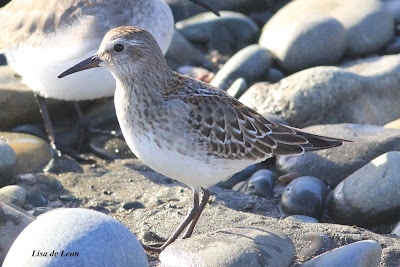It happens more than I would like, but this time it really got me! Early yesterday morning, I headed out to a favorite place sheltered from the south winds. The temp was perfect and the wind was low, but the viewing conditions were not great. It was too early. My camera was cranked up to 2500 ISO with a wide aperture and slow shutter speed, all ready (I thought) to capture whatever I saw.
When I drove up to Cuckhold's Cove, a small bird darted across the trail. Ah ha! I was right, there were going to be birds. I got out and quietly started to spy movement in the alders. I finally tracked my small bird and identified it as a Song Sparrow. Disappointing, but not deterring.... there were other birds in the area. Juncos and chickadees flitted all about.
Then, I spotted a small reddish brown bird moving low and deep in the leaf-laden alders. I would catch a fleeting look at it every now and then, enough to know it was something worth pursuing. This went on for more than 20 minutes. As the day brightened, I could see more of the red-brown color and the small size. It was not a sparrow. I was determined to see this bird.
Every now and then, it would perch, but there was always an obstruction between me and the bird and with very little light, I couldn't get a single picture.
At last, it popped up into an apple tree and moved out on a branch. I saw it clearly, but was so taken by how different this bird was, I forgot all about my camera. There I stood, stunned, staring at the reddish-brown (rusty) bird with a pale breast in the dim light, and I still didn't know what it was. My impression was a small wren, but I didn't see the beak, so I couldn't in good consciousness call it a wren.
Having only about 5 seconds, it finally dawned on me....get a picture. Usually, in five second, I have multiple shots. What was I thinking? I wasn't. I was just so interested in seeing this different bird, for one of very few times, I actually forgot about my camera. Finally, it dawned on me....get a shot. I raised the camera and aimed at the dim-lit branch, but the bird was gone. All I got were three pitiful pics of a near-by junco. The shots were so dark on my camera, I didn't know if I had captured the bird or not. I had to wait until I got home to see. Even then, the shots were so dark, I really couldn't tell.
I doctored the images enough to sift a noisy, under-exposed image to the forefront. The bird didn't look brown at all, but gray. It turns out, I missed the bird altogether and snagged a nearby junco. All I have left of the mystery bird is the image burned into my brain.
Now, where do you think I am going this morning? There is not much chance the bird is still around, but I have to try to relocate it just to quiet my niggling curiosity. Should I get lucky, I will post more about the bird. If I don't relocate it, I don't want to talk about it any more.


































































